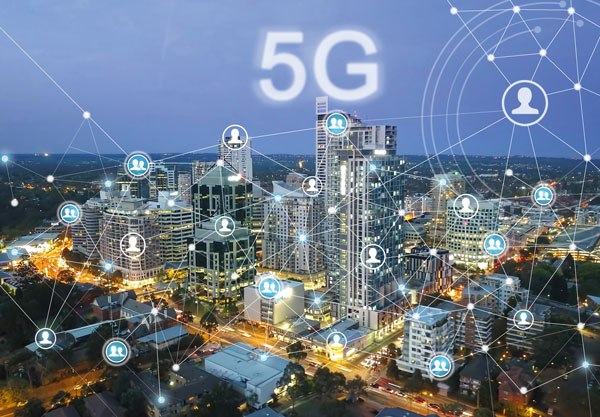by Hans van den Berg (UT, TNO and CWI), Rob van der Mei (CWI, VU) and Peter van de Ven (CWI)
5G mobile communication is commonly seen as a key enabler for smart cities. It will deliver huge improvements in speed, throughput, device deployment, traffic capacity and latency needed by the smart city ecosystem. A major challenge, however, is how to roll-out the highly-dense 5G network infrastructure in urban environments, with highly complex planning constraints, in a cost efficient way.
Recent years have seen the emergence of the smart city concept, which aims to use countless sensors and ubiquitous computational power to enable applications such as smart road traffic control, improved surveillance, and virtual/augmented reality. In 2017, an inter-disciplinary team comprising representatives of big Dutch cities and the national government as well as researchers and representatives from Dutch industry, presented the “NL smart city strategy” [L1]. This strategy document describes how smart city-type applications rely heavily on a robust, low-latency, high-capacity mobile communication network that is able to connect numerous devices, and emphasises the need for an enhanced mobile communication infrastructure, such as emerging 5G networks, in order to realise the smart city concept.

5G will deliver huge improvements in speed, throughput, device deployment, traffic capacity and latency needed by the smart city ecosystem.
Picture: Shutterstock.
5G networks are currently being developed, with the initial roll-out taking place in 2020, and more features to be added over the next decade. They are expected to provide significantly higher data rates and lower latency than the current generation of cellular networks, enable the interconnection of millions of IoT devices, and provide fast and scalable access to computational power. First 5G field trials are currently set up in many major cities in Europe and beyond, including a planned trial with 5G in Amsterdam during the 2020 European soccer championship. While these trials are promising and show the significant potential of smart city applications supported by 5G, they also reveal that the design and planning of 5G networks is a critical issue that arises when trying to scale up these pilot projects to a full-edged smart city [L2].
In order to realise its potential, 5G includes a range of novel technologies and concepts, such as ultra-small cells/ultra-density, mmWave communication, extreme beamforming and mobile edge computing, where “cloudlets” are distributed throughout the network to allow for quick access to computational power.
Significant attention is devoted in research literature on how to control these resources in order to ensure service quality. However, our research is concerned with how to deploy the infrastructure in a cost efficient way, given the demands of the smart city environment. Here we are faced with various crucial decisions, such as where to place the antennas and mobile edge computing (MEC) servers, how to connect the small cells to the network core (fibre or wireless fronthaul/backhaul), and how to exploit existing infrastructure [1], [2]. These decisions involve constraints on the placement of the physical infrastructure, strongly heterogeneous, unpredictable and variable communication and computation demands, and very strict requirements on network performance and robustness. One consequence of these constraints and requirements may also be that cities will require network operators to cooperate and share communication infrastructure, further complicating the design process. Another complicating aspect is the intermittent nature of mmWave wireless channels to be used in 5G. In particular, the capacity of these high frequency channels (possibly also used for fronthaul/backhaul) may strongly fluctuate in the crowded and dynamic environment of a city.
We propose new heuristics to solve the corresponding huge, intrinsically difficult (NP-hard) optimisation problems arising in this context, as well as evolutionary algorithms for network “self-planning”. In particular, we will develop methods that exploit and combine model-based and data-driven (e.g., machine learning) techniques for timely prediction of bottlenecks in the network as well as appropriate (cost-efficient, sustainable) modifications to avoid these bottlenecks (cf. [3]). Special emphasis will be put on important requirements regarding robustness of the solutions, i.e., the resulting network designs should be (up to a certain extent) resistant against unpredictably strong traffic fluctuations or failures of network elements due to e.g. extreme weather conditions, vandalism, attacks or just breakdowns due to usage and aging. Related to this, we are also interested in questions like: “How sensitive are the network costs and resulting network performance to the specific network design/planning choices made?” Or: “To what extent are real-time 5G network management approaches able to deal with sub-optimal network design choices?” Insights into these questions are particularly relevant for the development of practically useful guidelines and heuristic approaches for 5G network planning. The ultimate goal of this project is to combine these results into a proof-of-concept network planning tool designed to assist network operators and cities in the roll-out of their 5G network.
Links:
[L1] NL Smart City Strategie. https://gsc3.city/smart-city-strategie/, 2017.
[L2] Joseph Brookes, How 5G Unlocks Smart Cities. https://which-50.com/how-5g-unlocks-smart-cities/, April 2018.
References:
[1] A. Tau_que et al.: “Planning wireless cellular networks of future: Outlook, challenges and opportunities”, IEEE Access, 5:4821-4845, 2017.
[2] X. Ge et al.: “5G ultra-dense cellular networks”, IEEE Wireless Communications, 23(1):72-79, 2016.
[3] J. Perez-Romero et al.: “Knowledge-based 5G radio access network planning and optimization”, in Proc. of ISWCS 2016, Poznan, Poland, 20-23 September 2016, pp. 359-365.
Please contact:
Hans van den Berg (UT, TNO and CWI), the Netherlands,











